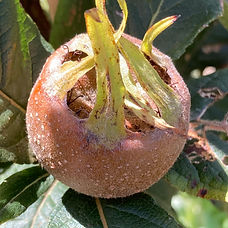Other Fruit Trees
Berries | Feijoas | Nuts | Medlars | Loquats | Hawthorns | Jujubes | Pomegranate | American Pawpaw | Fingerlime | White Sapote...

Cornelian cherry Cornus mas (Cornaceae)
A deciduous shrub/tree, flowering very early in the season with clusters of yellow flowers. It is a vigorous and tough unusual fruiting tree that will produce red olive-sized sweet and tart fruits. Great fresh or in preserves. Cross pollination recommended.
Red star
Jollico
Elegans

Saskatoons Amelanchier alnifolia (Rosaceae)
Originating from North America, Amelanchiers are easy to grow deciduous shrubs reaching 2,5 m high. It produces abundant white perfumed flowers in spring followed by very sweet fruits resembling blueberries early summer. Its firry autumn colours are eye-catching.
Some varieties have been selected for the better quality of their fruits. We grow:
Smokey
Northline
Pembina

Maqui berry Aristotelia chiliensis
A medium size tree (up to 5 m) from the Andes producing white flowers in spring followed by small black berries. Fruits are highly considered for their medicinal properties. Cross pollination recommended.

Feijoas Acca sellowiana (Myrtaceae)
Originally from south America and very appreciated in New Zealand, this 3 m shrub in gaining popularity worldwide. Cold hardy to -10, evergreen, hedging plant with beautiful edible flowers, it ticks all the boxes in our opinion. If you think that some nectarines or apples are tasteless (especially if you buy them at the supermarket), then you should try a feijoa! Very unique flavour full of aromas. Fruits in April-June
Most common varieties available in Australia:
Unique;
Mammoth:
Duffy:
Apollo:
Nazamete
Large Oval:
Triumph:
Hard to find :
Marion
Wiki Tu
Pale Star
Kakapo

Exquisites from the Canberra Project (courtesy of M O’C)
Kai Detto
Shaw
Dahl
Eleanor’s early
Andrews
E6
Hnatiuk

Walnuts
English walnut (Juglans regia)
Grafted on Juglans nigra. Cisco, Chanler, Tulare, Howard, Black Walnut (Juglans nigra).

Medlars
Crataegus mespilus(Rosaceae)
Rustic small tree, forgotten about, it used to be very common and appreciated in most of Europe. It produces an abundance of golf ball size fruits in autumn. The fruits are edible when overripe and are high in vitamin C. Grafted on quince.
Dutch
Royal
Nottingham

Loquats Eriobotrya japonica (rosaceae)
It flowers in winter and will be the first tree to fruit in your garden. An evergreen tree up to 4 m tall. The fruits are the size of a small apricot, the skin ,even though edible, can be easily removed when fruits are ripe.
Sewel’s Prolific
Herds Mammouth
Enormity
Bessel brown
Chatsworth victory
Thames pride
Champagne
Nagasakiwase

Hawthorns
Crataegus sp. (Rosaceae)
Hawthorns are small trees up to 5 m tall. They produce edible fruits from late summer that hold on the trees until winter, making it a great ornament for the landscape.
C. Mexicana (yellow fruits)
C. Estivealis – Big red (red fruits)
C. Pinnatifida – Chinese Haw

Jujubes
Ziziphus jujube (Ramnaceae)
Cultivated for thousands of years, jujubes are making a comeback in the western culture. A small tree that can live hundreds of years. The fruits hang from branchlets and can be picked when turning brown in colour in autumn. Crunchy like an apple when fresh the very nutritious fruits can be dried and stored for months.
Li
Li2
Shanxi Li
Chico
Sherwood
Redland
Tigertooth
Suimen
Honey Jar
Sihong
Tong Bay
Sugarcane
Porteville

Pomegranate
Punica granatum (Lythraceae)
Cultivated since antiquity for its fruits, this highly ornamental shrub/tree has plenty to offer. Highly versatile and drought tolerant when established, it requires warm summers to develop the sweetest fruits.
Black: a rare and more ornamental variety praised for its very dark purple fruits and its long flowering season.
Azerbaijani
Wonderful
Kazake
Molar de Elche
Early Valley
Achik Dani
Jativa
Shepard special
Rosavaya

American Pawpaw
Asimina triloba (Annonaceae)
The cold hardy tree finds its origin in North America. Its fruits resembling small mangos are ripe in autumn. They contain several seeds surrounded by a creamy white to yellow flesh. Weighing up to 400g, mango, banana and passion fruit are commonly used to describe their unique taste. This highly ornamental tree grows slowly in its first years to establish its strong taproot system. Prefers shady locations in its first years. Crosspollination is required for most varieties.
Prima
Sunflower
Overleese
Pennsylvania Gold
Cherryville

Fingerlime
.

White sapote
.
